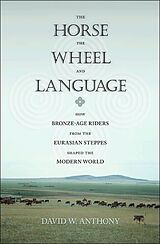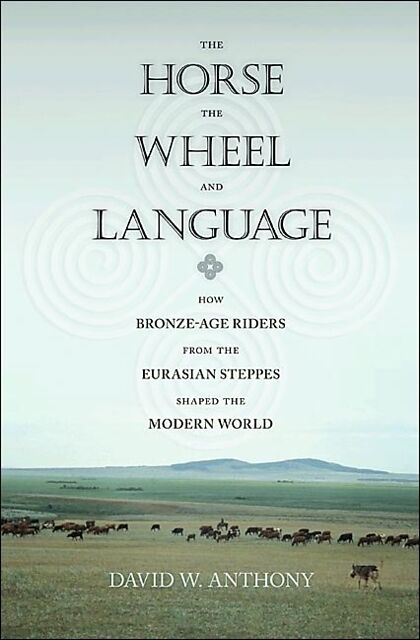The Horse, the Wheel, and Language
Einband:
Kartonierter Einband
EAN:
9780691148182
Untertitel:
How Bronze-Age Riders from the Eurasian Steppes Shaped the Modern World
Autor:
David W. Anthony
Herausgeber:
Princeton University Press
Auflage:
Repr.
Anzahl Seiten:
568
Erscheinungsdatum:
21.02.2011
ISBN:
978-0-691-14818-2
Zusatztext "A key book." ---David Keys, Independent Informationen zum Autor David W. Anthony is professor of anthropology at Hartwick College. He is the editor of The Lost World of Old Europe (Princeton). He has conducted extensive archaeological fieldwork in Ukraine! Russia! and Kazakhstan. Klappentext "If you want to learn about the early origins of English and related languages, and of many of our familiar customs such as feasting on holidays and exchanging gifts, this book provides a lively and richly informed introduction. Along the way you will learn when and why horses were domesticated, when people first rode horseback, and when and why swift chariots changed the nature of warfare."--Peter S. Wells, author of "The Battle that Stopped Rome" "A very significant contribution to the field. This book attempts to resolve the longstanding problem of Indo-European origins by providing an examination of the most relevant linguistic issues and a thorough review of the archaeological evidence. I know of no study of the Indo-European homeland that competes with it."--J. P. Mallory, Queen's University, Belfast Zusammenfassung Roughly half the world's population speaks languages derived from a shared linguistic source known as Proto-Indo-European. But who were the early speakers of this ancient mother tongue, and how did they manage to spread it around the globe? Until now their identity has remained a tantalizing mystery to linguists, archaeologists, and even Nazis seeking the roots of the Aryan race. The Horse, the Wheel, and Language lifts the veil that has long shrouded these original Indo-European speakers, and reveals how their domestication of horses and use of the wheel spread language and transformed civilization. Linking prehistoric archaeological remains with the development of language, David Anthony identifies the prehistoric peoples of central Eurasia's steppe grasslands as the original speakers of Proto-Indo-European, and shows how their innovative use of the ox wagon, horseback riding, and the warrior's chariot turned the Eurasian steppes into a thriving transcontinental corridor of communication, commerce, and cultural exchange. He explains how they spread their traditions and gave rise to important advances in copper mining, warfare, and patron-client political institutions, thereby ushering in an era of vibrant social change. Anthony also describes his fascinating discovery of how the wear from bits on ancient horse teeth reveals the origins of horseback riding. The Horse, the Wheel, and Language solves a puzzle that has vexed scholars for two centuries--the source of the Indo-European languages and English--and recovers a magnificent and influential civilization from the past. Inhaltsverzeichnis 13018196 ...
"In its integration of language and archaeology, this book represents an outstanding synthesis of what today can be known with some certainty about the origin and early history of the Indo-European languages. In my view, it supersedes all previous attempts on the subject."---Kristian Kristiansen, Antiquity
Autorentext
David W. Anthony is professor emeritus of anthropology at Hartwick College and the editor of The Lost World of Old Europe (Princeton). He has conducted extensive archaeological fieldwork in Ukraine, Russia, and Kazakhstan.
Klappentext
"If you want to learn about the early origins of English and related languages, and of many of our familiar customs such as feasting on holidays and exchanging gifts, this book provides a lively and richly informed introduction. Along the way you will learn when and why horses were domesticated, when people first rode horseback, and when and why swift chariots changed the nature of warfare."--Peter S. Wells, author of The Battle that Stopped Rome"A very significant contribution to the field. This book attempts to resolve the longstanding problem of Indo-European origins by providing an examination of the most relevant linguistic issues and a thorough review of the archaeological evidence. I know of no study of the Indo-European homeland that competes with it."--J. P. Mallory, Queen's University, Belfast
Zusammenfassung
"A fascinating look into the origins of modern man."—Publishers Weekly
A book that solves the mystery of the people who spread the ancient mother tongue that gave us English and the other languages spoken by half of humanity today
"Authoritative."—New York Times • "A masterpiece."—Wilson Quarterly
Roughly half the world's population speaks languages derived from a shared linguistic source known as Proto-Indo-European. But who were the early speakers of this ancient mother tongue, and how did they manage to spread it around the globe? Until now their identity has remained a tantalizing mystery to linguists, archaeologists, and even Nazis seeking the roots of the Aryan race. The Horse, the Wheel, and Language lifts the veil that has long shrouded these original Indo-European speakers, and reveals how their domestication of horses and use of the wheel spread language and transformed civilization.
Linking prehistoric archaeological remains with the development of language, David Anthony identifies the prehistoric peoples of central Eurasia's steppe grasslands as the original speakers of Proto-Indo-European, and shows how their innovative use of the ox wagon, horseback riding, and the warrior's chariot turned the Eurasian steppes into a thriving transcontinental corridor of communication, commerce, and cultural exchange. He explains how they spread their traditions and gave rise to important advances in copper mining, warfare, and patron-client political institutions, thereby ushering in an era of vibrant social change. Anthony also describes his fascinating discovery of how the wear from bits on ancient horse teeth reveals the origins of horseback riding.
The Horse, the Wheel, and Language solves a puzzle that has vexed scholars for two centuries—the source of the Indo-European languages and English—and recovers a magnificent and influential civilization from the past.
Inhalt
Acknowledgments xi PART ONE: Language and Archaeology 1 Chapter One: The Promise and Politics of the Mother Tongue 3 Ancestors 3 Linguists and Chauvinists 6 The Lure of the Mother Tongue 11 A New Solution for an Old Problem 15 Language Extinction and Thought 19 Chapter Two: How to Reconstruct a Dead Language 21 Language Change and Time 22 Phonology: How to Reconstruct a Dead Sound 24 The Lexicon: How to Reconstruct Dead Meanings 32 Syntax and Morphology: The Shape of a Dead Language 36 Conclusion: Raising a Language from the Dead 38 Chapter Three: Language and Time 1: The Last Speakers of Proto-Indo-European 39 The Size of the Chronological Window: How Long Do Languages Last? 39 The Terminal Date for Proto-Indo-European: The Mother Becomes Her Daughters 42 The Oldest and Strangest Daughter (or Cousin?): Anatolian 43 The Next Oldest Inscriptions: Greek and Old Indic 48 Counting the Relatives: How Many in 1500 BCE? 50 Chapter Four: Language and Time 2: Wool, Wheels, and Proto-Indo-European 59 The Wool Vocabulary 59 The Wheel Vocabulary 63 When Was the Wheel Invented 65 The Signifi cance of the Wheel 72 Wagons and the Anatolian Homeland Hypothesis 75 The Birth and Death of Proto-Indo-European 81 Chapter Five: Language and Place: The Location of the Proto-Indo-Europe an Homeland 83 Problems with the Concept of "the Homeland" 83 Finding the Homeland: Ecology and Environment 89 Finding the Homeland: The Economic and Social Setting 91 Finding the Homeland: Uralic and Caucasian Connections 93 The Location of the Proto-Indo-European Homeland 98 Chapter Six: The Archaeology of Language 102 Persistent Frontiers 104 Migratio…

Leider konnten wir für diesen Artikel keine Preise ermitteln ...
billigbuch.ch sucht jetzt für Sie die besten Angebote ...
Die aktuellen Verkaufspreise von 6 Onlineshops werden in Realtime abgefragt.
Sie können das gewünschte Produkt anschliessend direkt beim Anbieter Ihrer Wahl bestellen.
Loading...
Die aktuellen Verkaufspreise von 6 Onlineshops werden in Realtime abgefragt.
Sie können das gewünschte Produkt anschliessend direkt beim Anbieter Ihrer Wahl bestellen.
| # | Onlineshop | Preis CHF | Versand CHF | Total CHF | ||
|---|---|---|---|---|---|---|
| 1 | Seller | 0.00 | 0.00 | 0.00 |
